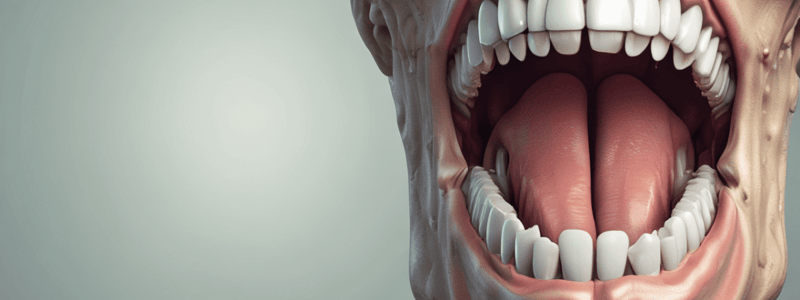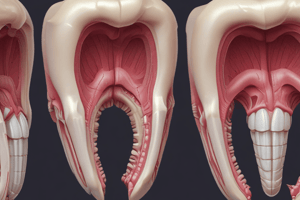Podcast
Questions and Answers
During which phase of tooth development do the sites of future teeth become established?
During which phase of tooth development do the sites of future teeth become established?
- Histogenesis
- Initiation (correct)
- Calcification
- Morphogenesis
What is the outcome of the histogenesis phase of tooth development?
What is the outcome of the histogenesis phase of tooth development?
- Fully formed dental tissues (correct)
- Formation of tooth germs
- Eruption of teeth
- Determination of tooth shape
Which of the following is NOT a stage of dentition?
Which of the following is NOT a stage of dentition?
- Mixed dentition
- Permanent dentition
- Adult dentition (correct)
- Primary dentition
What is the role of the dental papilla in tooth development?
What is the role of the dental papilla in tooth development?
During which stage of dentition do we see the coexistence of primary and permanent teeth?
During which stage of dentition do we see the coexistence of primary and permanent teeth?
At what prenatal week does the dental lamina begin to function?
At what prenatal week does the dental lamina begin to function?
What is the origin of the dental organ?
What is the origin of the dental organ?
What is the main function of the vestibular lamina?
What is the main function of the vestibular lamina?
What is the outcome of the morphogenesis phase of tooth development?
What is the outcome of the morphogenesis phase of tooth development?
What is the result of the interaction between epithelial and mesenchymal cells during tooth development?
What is the result of the interaction between epithelial and mesenchymal cells during tooth development?
During which stage of tooth development does the enamel organ appear as a simple, spherical to ovoid shape?
During which stage of tooth development does the enamel organ appear as a simple, spherical to ovoid shape?
What is the source of the epithelial component of the developing tooth?
What is the source of the epithelial component of the developing tooth?
During which stage of tooth development does the enamel organ invaginate to form a cap-shaped structure?
During which stage of tooth development does the enamel organ invaginate to form a cap-shaped structure?
What is the result of the rapid enlargement and degeneration of the vestibular lamina cells?
What is the result of the rapid enlargement and degeneration of the vestibular lamina cells?
Until what age does the dental lamina continue to function?
Until what age does the dental lamina continue to function?
What is the correct sequence of tooth development stages?
What is the correct sequence of tooth development stages?
Which of the following cell types is NOT found within the enamel organ?
Which of the following cell types is NOT found within the enamel organ?
What is the function of the enamel organ during tooth development?
What is the function of the enamel organ during tooth development?
What structure forms from the condensation of mesenchyme beneath the internal enamel epithelium?
What structure forms from the condensation of mesenchyme beneath the internal enamel epithelium?
What is the future site of the dentin-enamel junction (DEJ)?
What is the future site of the dentin-enamel junction (DEJ)?
Which of the following structures surrounds the enamel organ and condenses to form the dental sac or follicle?
Which of the following structures surrounds the enamel organ and condenses to form the dental sac or follicle?
What is the role of enamel knots in tooth development?
What is the role of enamel knots in tooth development?
Which of the following is NOT a characteristic of the cap stage of tooth development?
Which of the following is NOT a characteristic of the cap stage of tooth development?
What is the main difference between the outer enamel epithelium and the inner enamel epithelium?
What is the main difference between the outer enamel epithelium and the inner enamel epithelium?
Which of the following correctly describes the role of the outer enamel epithelium (OEE) in tooth development?
Which of the following correctly describes the role of the outer enamel epithelium (OEE) in tooth development?
During which stage of tooth development does the dental papilla differentiate into two types of cells?
During which stage of tooth development does the dental papilla differentiate into two types of cells?
What is the primary function of the stellate reticulum in the enamel organ?
What is the primary function of the stellate reticulum in the enamel organ?
What is the name given to the remnants of the dental lamina that may remain in the jaws?
What is the name given to the remnants of the dental lamina that may remain in the jaws?
Which of the following cell types is characterized by a high level of alkaline phosphatase activity?
Which of the following cell types is characterized by a high level of alkaline phosphatase activity?
Which of the following correctly describes the process of morphodifferentiation?
Which of the following correctly describes the process of morphodifferentiation?
At what stage of tooth development does the dental sac differentiate into periodontal fibers?
At what stage of tooth development does the dental sac differentiate into periodontal fibers?
What is the primary function of the cervical loop?
What is the primary function of the cervical loop?
What is the main difference between the inner enamel epithelium (IEE) and the outer enamel epithelium (OEE) in terms of their function?
What is the main difference between the inner enamel epithelium (IEE) and the outer enamel epithelium (OEE) in terms of their function?
What is the main characteristic that differentiates the late bell stage from earlier stages?
What is the main characteristic that differentiates the late bell stage from earlier stages?
Which cell type in the enamel organ is responsible for the secretion of enamel?
Which cell type in the enamel organ is responsible for the secretion of enamel?
Which of the following nutrients are crucial for healthy tooth development?
Which of the following nutrients are crucial for healthy tooth development?
Which of the following is NOT a feature of the inner enamel epithelium (IEE)?
Which of the following is NOT a feature of the inner enamel epithelium (IEE)?
What is the timeframe for the dental lamina to be functional in developing teeth?
What is the timeframe for the dental lamina to be functional in developing teeth?
Which cells of the dental papilla differentiate into cementoblasts?
Which cells of the dental papilla differentiate into cementoblasts?
During which stage of tooth development does the tooth lose its connection with the dental lamina?
During which stage of tooth development does the tooth lose its connection with the dental lamina?
Flashcards are hidden until you start studying
Study Notes
Tooth Development (Odontogenesis)
- Tooth development involves many complex biological processes: epithelial-mesenchymal interaction, morphogenesis, and calcification (mineralization).
Dentition
- Dentition is the process of teeth eruption, occurring in different stages of human life.
- There are three stages of dentition: primary dentition (20 teeth), permanent dentition (32 teeth), and mixed dentition period (between primary and permanent dentition).
Tooth Derivation
- Teeth are derived from three embryonic layers: ectoderm (enamel organ), mesoderm (dental papilla), and mesoderm (dental sac).
Tooth Development Phases
- Tooth development can be divided into three phases: initiation, morphogenesis, and histogenesis.
Initiation Phase
- During the initiation phase, the sites of future teeth are established with the appearance of tooth germs called dental lamina.
Morphogenesis Phase
- During the morphogenesis phase, the shape of the teeth is determined by a combination of cell proliferation and cell movement.
Histogenesis Phase
- During the histogenesis phase, cell differentiation proceeds to give rise to fully formed dental tissues, both mineralized (enamel, dentin, and cementum) and unmineralized (pulp and periodontal ligaments).
Tooth Development Stages
- The stages of tooth development are: initiation stage (6-7 weeks), bud stage (8 weeks), cap stage (9-10 weeks), bell stage (11-12 weeks), apposition stage (varies per tooth), and maturation stage (varies per tooth).
Bud Stage
- The bud stage is characterized by the incursion of epithelium into the mesenchyme, and the enamel organ appears as a simple, spherical to ovoid structure.
Cap Stage
- The cap stage is characterized by the continuation of the ingrowth of the oral epithelium into the mesenchyme, and the tooth bud of the dental lamina proliferates unequally to form a cap-shaped tissue.
Bell Stage
- During the bell stage, differentiation produces four types of cells within the enamel/dental organ: inner enamel epithelium, outer enamel epithelium, stellate reticulum, and stratum intermedium.
Dental Papilla
- The dental papilla undergoes differentiation and produces two types of cells: outer cells that form dentin-secreting cells (odontoblasts) and central cells that form the primordium of the pulp.
Dental Sac
- The dental sac shows a circular arrangement of its fibers and resembles a capsular structure before the formation of dental hard tissue begins.
Late Bell Stage (Apposition and Maturation Stage)
- The late bell stage represents the final stage of odontogenesis, characterized by apposition and maturation of dental tissues.
Fate of Dental Lamina
- The dental lamina is functional in developing 52 teeth from 6 prenatal weeks until 4 years after birth.
- The dental lamina degenerates by mesenchymal invasions in the late bell stage.
- Remnants of dental lamina may remain in the jaws as epithelial rests of Serres (Serres' pearls).
Nutrition and Tooth Development
- Nutrition has an effect on the developing tooth.
- Essential nutrients for a healthy tooth include calcium, phosphorus, and vitamins A, C, and D.
Studying That Suits You
Use AI to generate personalized quizzes and flashcards to suit your learning preferences.




